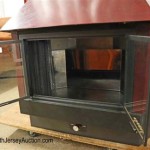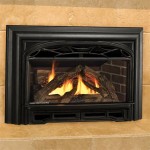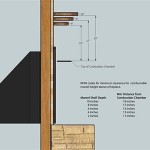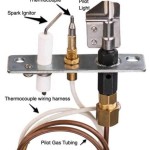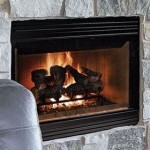Understanding EPA Fireplace Inserts: Efficiency, Regulations, and Considerations
Fireplace inserts offer a practical and aesthetically pleasing solution for improving the efficiency and functionality of existing masonry fireplaces. An Environmental Protection Agency (EPA) certified fireplace insert goes a step further, complying with strict emission standards aimed at reducing air pollution. This article delves into the world of EPA fireplace inserts, exploring their benefits, regulatory context, key features, and considerations for choosing the right model.
The fundamental purpose of a fireplace insert is to transform an open fireplace, which is typically inefficient and can even draw heat from the home, into a more effective heating appliance. Open masonry fireplaces tend to lose a significant portion of heat up the chimney, creating a negative pressure that pulls warm air out of the living space. An insert, essentially a sealed metal firebox, is placed directly into the existing fireplace opening, drastically reducing heat loss and improving overall heating performance.
EPA certification adds another layer of importance to selecting a fireplace insert. These certified models are designed and manufactured to burn wood more cleanly, releasing significantly fewer pollutants into the atmosphere. This is crucial for both environmental protection and compliance with local regulations that increasingly mandate the use of EPA-certified heating appliances.
What is EPA Certification for Fireplace Inserts?
The EPA sets emission standards for wood-burning appliances, including fireplace inserts, to minimize the release of particulate matter (PM2.5), carbon monoxide (CO), and other harmful pollutants. EPA certification signifies that a particular fireplace insert has been tested and proven to meet these established standards. These standards have evolved over time, with progressively stricter limits to encourage manufacturers to develop cleaner-burning technologies.
The testing process typically involves independent laboratory testing that follows specific EPA-approved protocols. These tests evaluate the insert's emissions performance across a range of burning conditions. If the insert meets the required emission limits, it receives EPA certification and is allowed to be sold and installed in areas that require or recommend certified appliances.
Consumers can identify EPA-certified fireplace inserts by looking for a label affixed to the unit. This label contains information about the manufacturer, model number, and emission rate. It is important to retain this label for record-keeping purposes, especially if the appliance is located in an area with specific regulations.
The benefits of choosing an EPA-certified insert extend beyond simply meeting regulatory requirements. Cleaner burning translates to improved air quality, reduced health risks, and a smaller environmental footprint. Furthermore, EPA-certified inserts often feature advanced combustion technologies that lead to more efficient fuel consumption and longer burn times.
Key Features of EPA-Certified Fireplace Inserts
EPA-certified fireplace inserts incorporate several key features that contribute to their clean-burning performance and overall efficiency. These features are a result of ongoing innovation and engineering efforts to meet stringent emission standards.
Air Wash System: This system utilizes strategic air jets to keep the glass door of the insert clean. A curtain of air flows across the inside of the glass, preventing soot and creosote from accumulating and obscuring the view of the fire. This not only enhances the aesthetic appeal of the insert but also ensures that the fire is visible for monitoring and adjustment.
Secondary Combustion: EPA-certified inserts commonly employ secondary combustion systems. These systems introduce preheated air into the firebox above the primary combustion zone. This secondary air helps to burn off unburned gases and particulate matter that would otherwise be released as emissions. Secondary combustion significantly reduces pollution and increases heat output.
Catalytic or Non-Catalytic Combustion: Some EPA-certified inserts utilize catalytic combustors, while others rely on non-catalytic designs. Catalytic combustors are honeycomb-shaped devices coated with precious metals that promote oxidation of pollutants at lower temperatures. Non-catalytic inserts achieve clean burning through carefully engineered firebox designs, including insulated fireboxes and precise air control.
Controlled Air Intake: Precise control over the amount of air entering the firebox is crucial for efficient and clean burning. EPA-certified inserts feature adjustable air controls that allow users to regulate the combustion rate and optimize the burning process. This control helps to maintain consistent heat output and minimize emissions.
Blower Systems: Many fireplace inserts are equipped with integrated blower systems that circulate heated air into the room. These blowers enhance the insert's heating capacity by distributing warm air more effectively throughout the living space. The blowers are often thermostatically controlled to maintain a consistent temperature.
Durable Construction: EPA-certified inserts are typically constructed from heavy-gauge steel or cast iron to ensure durability and longevity. These materials can withstand the high temperatures and stresses associated with wood burning. The build quality is an important factor to consider when evaluating different insert models.
Factors to Consider When Choosing an EPA Fireplace Insert
Selecting the right EPA-certified fireplace insert requires careful consideration of several factors, including the size of the area to be heated, the existing fireplace opening dimensions, local regulations, and personal preferences.
Heating Capacity: Fireplace inserts are rated by British Thermal Units (BTUs), which indicate their heating capacity. It is important to choose an insert with a BTU rating that is appropriate for the size of the space to be heated. An undersized insert may not provide adequate heat, while an oversized insert can lead to overheating and inefficient fuel consumption.
Firebox Size: The size of the firebox determines the length of the wood that can be burned. A larger firebox allows for longer burn times and less frequent reloading. Consider the typical size of the wood available and choose an insert with a firebox that can accommodate it.
Fireplace Opening Dimensions: The insert must fit properly into the existing fireplace opening. Measure the height, width, and depth of the opening carefully to ensure that the insert will fit. Some inserts come with adjustable surrounds that can be used to cover gaps between the insert and the fireplace facade.
Fuel Type: While most EPA-certified inserts are designed for burning seasoned firewood, some models can also burn other fuels, such as wood pellets or coal. Consider the availability and cost of different fuel types when making a selection.
Efficiency Rating: The efficiency rating indicates the percentage of energy in the fuel that is converted into usable heat. Higher efficiency ratings translate to lower fuel consumption and reduced heating costs. Look for inserts with high efficiency ratings to maximize fuel savings.
Emissions Rating: The emissions rating indicates the amount of particulate matter released by the insert. Lower emissions ratings indicate cleaner burning. Choose an insert with a low emissions rating to minimize air pollution and comply with local regulations.
Aesthetics: Fireplace inserts are available in a variety of styles and finishes to complement different home decors. Consider the aesthetic appeal of the insert and choose a model that matches the overall design of the living space. Options include different door styles, finishes, and trim kits.
Installation Requirements: Proper installation is crucial for safe and efficient operation. It is recommended to have the insert installed by a qualified professional who is familiar with local building codes and regulations. The installation typically involves connecting the insert to the existing chimney using a stainless steel liner. The chimney should be inspected and cleaned before installing the insert.
Local Regulations: It is essential to check local regulations regarding wood-burning appliances before purchasing and installing a fireplace insert. Some areas have restrictions on the type of appliances that can be used, as well as permit requirements for installation. Ensure that the chosen insert complies with all applicable regulations.
Cost: The cost of a fireplace insert can vary depending on the size, features, and brand. Consider the total cost of ownership, including the purchase price, installation costs, and ongoing maintenance expenses. While EPA-certified inserts may have a higher initial cost, the long-term benefits of improved efficiency and reduced emissions can often offset the difference.
Maintenance: Regular maintenance is necessary to ensure the continued efficient and safe operation of the fireplace insert. This includes cleaning the chimney regularly to remove creosote buildup, inspecting the door seals and gaskets, and checking the air controls. Following the manufacturer's recommended maintenance schedule can help to prolong the life of the insert and maintain its performance.
By carefully considering these factors, homeowners can select an EPA-certified fireplace insert that meets their heating needs, complies with environmental regulations, and enhances the comfort and aesthetics of their homes.
In conclusion, EPA fireplace inserts represent a substantial improvement over traditional open fireplaces. They provide a more efficient, environmentally friendly, and aesthetically pleasing heating solution. Understanding the key features, regulations, and considerations outlined above is vital in making an informed decision when choosing the right insert for a specific living space.

Epa Certified Zero Clearance Wood Burning Fireplaces

T25i Timberwolf Wood Fireplace Insert Hearth Stove Patio

Napoleon Epi3 Wood Fireplace Insert Inserts By

Large Flush Wood Rectangular Nexgen Fyre Made In America Fireplace Xtrordinair

Superior White Stacked Epa Certified Wood Fireplace Wct6940 North Country Fire

T20i Timberwolf Wood Fireplace Insert Hearth Stove Patio

Napoleon S20i Wood Burning Fireplace Insert

Supreme Fireplaces

Us Stove Wood Burning Epa Certified Fireplace Insert For 1 200 Sq Ft Rooms At Tractor Supply Co

Ventis Hei240 Wood Fireplace Insert Mace Energy Supply

